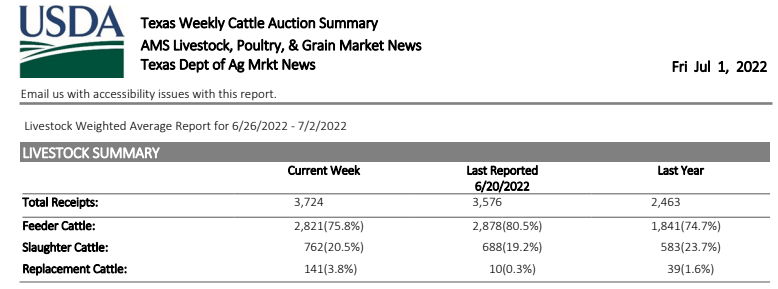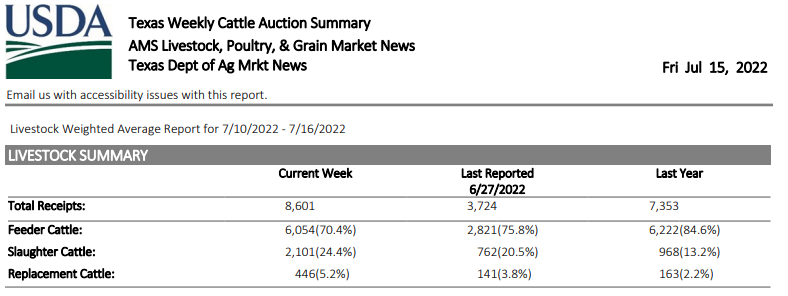We are firmly into an ENSO phase in the United States that could be regarded as the essence of the word dire. Milestones in Texas the past two weeks from a drought, weather, and a livestock production perspective are coming fast and often. Largely throughout the entire west – it’s hot, dry, and uncomfortable, both from a producer perspective but also as a common person, and more so for livestock out on the range with very little way of seeking protections from temperatures and extremes in lack of rain. We are and have stayed in a triple digit territory and the grass fires have started two months early. Thanks to the entire population, we have collectively understood and prevented grass, forest, and large land fires as per recent. As with any dry
Topics:
Michael Smith considers the following as important: agriculture, climate change, Featured Stories, Michael Smith, US EConomics
This could be interesting, too:
NewDealdemocrat writes JOLTS revisions from Yesterday’s Report
Ken Melvin writes A Developed Taste
Bill Haskell writes The North American Automobile Industry Waits for Trump and the Gov. to Act
Bill Haskell writes Families Struggle Paying for Child Care While Working
We are firmly into an ENSO phase in the United States that could be regarded as the essence of the word dire. Milestones in Texas the past two weeks from a drought, weather, and a livestock production perspective are coming fast and often. Largely throughout the entire west – it’s hot, dry, and uncomfortable, both from a producer perspective but also as a common person, and more so for livestock out on the range with very little way of seeking protections from temperatures and extremes in lack of rain. We are and have stayed in a triple digit territory and the grass fires have started two months early.
Thanks to the entire population, we have collectively understood and prevented grass, forest, and large land fires as per recent. As with any dry tender, sometimes a mower blade hitting a rock will cause an entire field to burn. Such is life in a changing climate world. Heat, extended drought, and half the country a tender box for the next act of God or human awaits. A lot has been learned from the fires of 2011 in Texas, and from the ongoing wildfire tragedies from all around the country. Our unsung heroes, the fire fighters and the forest service have been in all out assault to keep life moving, jumping on outbursts as soon as they flare up.
One thing to note during my hiatus, corn acres rose modestly, but soybean acres got a severe haircut.
Let’s talk about cattle. This time last year when we first did the ’21 mid year cattle report, we had record profits enjoyed by the processors, while the stock yards and feedlots stayed relatively unchanged. The narrative of the prior year was lack of required labor in a post pandemic world that kept the price of beef up at the local retailers, while paying the in the field producers pennies per pound of protein stock grown in their fields. This year is no different. National media has picked up the narrative of massive shifts of cattlemen and women pushing to unload their head of cattle as quickly as possible. This was true almost three weeks ago, as we saw year over year the number of head almost double, as indicated by the USDA total head moved report out of Amarillo.

As of current reporting, this trend has begun to wane, moving closer to historical year over year sales within the larger auction houses.

Now, there is some truth to the large media reports of auction barns with trailers of cattle waiting to be auctioned that well down the county roads waiting for their queue for bids, but these are mostly smaller barns, or hyper regional, and are not indicative of the totality of the cattle market. Think, stock yards that have an abundance of cattle that need to move to the feeders, well, if the feeders don’t have space, and the feeders don’t have fed cattle ready for the producers at weight the packers want, the entire attrition ladder will not speed up, but keep its current cadence. We see this with oil and gas, we can drill all the oil we want but without additional refining capacity, the crude product is going to sit in storage, or in this case, the cattle will be backgrounded until they have their shot at the feedlot. As with all large corporations, preservation of profit and mitigating loss is the top mission of the corporation and maximizing shareholder profit is the entire existence of the board. As we dive deeper into that means, we can dig into the packers and what mitigating steps they have in place to stem the ebbs and flows of glut or shortage of product coming off the feedlots, should something dramatic happen. As for Cargill, a request was sent in January of this year to detail their private storage lockers where FDA and USDA approved and inspected facilities are located in the following cities, strategically placed around the country:

The exact size and composition of these facilities is not known, Cargill is a private company and as such, does not have to publicly disclose how large or how much product is stored, but does state:
These locations adhere to and fall under the compliance of 21 CFR 117 and 21 CFR 110.93 for our cold storagefacilities. With regard to Cargill’s Food and Drug Administration (FDA) Facility Registrations, Cargill’s facility registrationswere renewed on or before December 31, 2020 and are in effect through December 31, 2022. Registration numbers areconsidered as being confidential; therefore, Cargill does not disclose that information. As applicable, Cargill adheres tothe requirement for FDA inspected facilities to be registered pursuant to the Public Health and BioterrorismPreparedness and Response Act of 2002.
Meaning we don’t know what the registration information regarding these strategic locations should hold, be, or conducted under, but they do fit government cold storage standards. When done properly, cold storage of proteins can last months and potentially a year, under the right conditions, with no loss of overall quality of the packaged product. All that being said, yes, we are in a drought and are feeding hay and forage to cattle now instead of for winter, but we do have other levers producers can pull in order to successfully feed the public. We have a global supply chain where silage can be obtained and easter states that can and will help out western, for example hauling water west to dairy barns operated by the Dairy Farmers of America. Agriculture is all about hope and meeting the expectations of the public. We might be somewhat silent but are committed to the support of the nation regardless of where we stand politically or socially.
